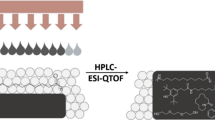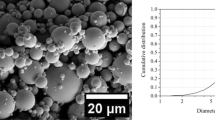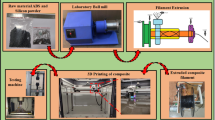Abstract
Additive manufacturing (AM) is gaining considerable interest due to the inherent capacity of fast and low-cost prototyping of customized devices and parts. In this work, seventeen commercial thermoplastic polymer filaments (PLA, TPU, and ABS) and one PLA pellet for fused deposition modeling (FDM) were characterized and evaluated to develop a disposable sample holder to be used as a solid sampling platform in graphite furnace atomic absorption spectroscopy (GFAAS). For GFAAS application, the selection of polymer filaments took into account no or minimal mass residue, decomposition profile, the lowest thermal decomposition temperatures, and colorless filament (preferably). These conditions are essential for the rapid and complete elimination of polymeric matrix without generating residues inside the graphite tube atomizer and lower analytical blanks. Thus, the filaments and pellets were characterized by thermogravimetry, derivative thermogravimetry, differential thermal analysis, differential scanning calorimetry, Fourier-transform infrared spectroscopy and scanning electron microscopy/energy-dispersive X-ray spectroscopy. It is desirable that the sample holder can be entirely decomposed at the lowest possible temperature. The PLA pellet material was chosen because it presented glass transition 71.7 \(^\circ\)C, melting temperature at 182.7 \(^\circ\)C, and showed single decomposition step in the 245–325 \(^\circ\)C range (with peak temperature at 304.4 \(^\circ\)C), without generating mass residue. The printed sample holder was tested in a commercial spectrometer. As “proof-of-concept," the calibration curve for cobalt (0–9.0 ng) was built up with a correlation coefficient of 0.9987. The RSD was < 10%, and the quantification limit was 1.18 ng. Recoveries of Co added to water samples varied from 96–102%.








Similar content being viewed by others
References
Guo N, Leu MC. Additive manufacturing: technology, applications and research needs. Front Mech Eng. 2013;8(3):215–43. https://doi.org/10.1007/s11465-013-0248-8.
Ngo TD, Kashani A, Imbalzano G, Nguyen KTQ, Hui D. Additive manufacturing (3D printing): a review of materials, methods, applications and challenges. Compos Part B Eng. 2018;143:172–96.
Wong KV, Hernandez A. A review of additive manufacturing. ISRN Mech Eng.;2012:1–10. https://www.hindawi.com/archive/2012/208760/.
Herzog D, Seyda V, Wycisk E, Emmelmann C. Additive manufacturing of metals. Acta Mater. 2016;117:371–92.
Frazier WE. Metal additive manufacturing: a review. J Mater Eng Perform. 2014;23(6):1917–28. https://doi.org/10.1007/s11665-014-0958-z.
Ligon SC, Liska R, Stampfl J, Gurr M, Mülhaupt R. Polymers for 3D printing and customized additive manufacturing. Chem Rev. 2017;117(15):10212–90. https://doi.org/10.1021/acs.chemrev.7b00074.
Yan L, Sun H, Qu X, Zhou W. The fused deposition modeling 3D printing. In: Proceedings of the interational conference on electrical mechanical industrial engineering. Paris, France: Atlantis Press; 2016. http://www.atlantis-press.com/php/paper-details.php?id=25853902.
Mohamed OA, Masood SH, Bhowmik JL. Optimization of fused deposition modeling process parameters: a review of current research and future prospects. Adv Manuf. 2015;3(1):42–53. https://doi.org/10.1007/s40436-014-0097-7.
Masood SH. Advances in fused deposition modeling. In: Comprehensive materials processing, p. 69–91
Matos BDM, Rocha V, da Silva EJ, Moro FH, Bottene AC, Ribeiro CA, et al. Evaluation of commercially available polylactic acid (PLA) filaments for 3D printing applications. J Therm Anal Calorim. 2019;137(2):555–62. https://doi.org/10.1007/s10973-018-7967-3.
Pohanka M. Three-dimensional printing in analytical chemistry: principles and applications. Anal Lett. 2016;49(18):2865–82. https://doi.org/10.1080/00032719.2016.1166370.
Gusmão R, Browne MP, Sofer Z, Pumera M. The capacitance and electron transfer of 3D-printed graphene electrodes are dramatically influenced by the type of solvent used for pre-treatment. Electrochem Commun. 2019;102:83–8.
Vaněčková E, Bouša M, Nováková Lachmanová Š, Rathouský J, Gál M, Sebechlebská T, et al. 3D printed polylactic acid/carbon black electrodes with nearly ideal electrochemical behaviour. J Electroanal Chem. 2020;857:113745.
Bressan LP, Robles-Najar J, Adamo CB, Quero RF, Costa BMC, de Jesus DP, et al. 3D-printed microfluidic device for the synthesis of silver and gold nanoparticles. Microchem J. 2019;146:1083–9.
Bressan LP, Adamo CB, Quero RF, de Jesus DP, da Silva JAF. A simple procedure to produce FDM-based 3D-printed microfluidic devices with an integrated PMMA optical window. Anal Methods. 2019;11(8):1014–102.
Chen Y, Fu Q, Li D, Xie J, Ke D, Song Q, et al. A smartphone colorimetric reader integrated with an ambient light sensor and a 3D printed attachment for on-site detection of zearalenone. Anal Bioanal Chem. 2017;409(28):6567–74. https://doi.org/10.1007/s00216-017-0605-2.
O’Neil GD, Ahmed S, Halloran K, Janusz JN, Rodríguez A, Terrero Rodríguez IM. Single-step fabrication of electrochemical flow cells utilizing multi-material 3D printing. Electrochem Commun. 2019;99:56–60.
Pisaruka J, Dymond MK. A low volume 3D-printed temperature-controllable cuvette for UV visible spectroscopy. Anal Biochem. 2016;510:52–5.
Tyson AL, Hilton ST, Andreae LC. Rapid, simple and inexpensive production of custom 3D printed equipment for large-volume fluorescence microscopy. Int J Pharm. 2015;494(2):651–6.
Yamashita T, Yasukawa K, Yunoki E. Fabrication of a polydimethylsiloxane fluidic chip using a sacrificial template made by fused deposition modeling 3d printing and application for flow-injection analysis. Anal Sci. 2019;35(7):769–75.
Colares L, Pereira ÉR, Merib J, Silva JC, Silva JM, Welz B, et al. Application of disposable starch-based platforms for sample introduction and determination of refractory elements using graphite furnace atomic absorption spectrometry and direct solid sample analysis. J Anal At Spectrom. 2015;30(2):381–8.
Cicala G, Giordano D, Tosto C, Filippone G, Recca A, Blanco I. Polylactide (PLA) filaments a biobased solution for additive manufacturing: correlating rheology and thermomechanical properties with printing quality. Materials (Basel). 2018;11(7):1191.
Yang Sl WuZH, Yang W, Yang MB. Thermal and mechanical properties of chemical crosslinked polylactide (PLA). Polym Test. 2008;27(8):957–63.
Shankar S, Wang LF, Rhim JW. Incorporation of zinc oxide nanoparticles improved the mechanical, water vapor barrier, UV-light barrier, and antibacterial properties of PLA-based nanocomposite films. Mater Sci Eng C. 2018;93:289–98.
Haryńska A, Gubanska I, Kucinska-Lipka J, Janik H. Fabrication and characterization of flexible medical-grade TPU filament for fused deposition modeling 3dp technology. Polymers (Basel). 2018;10(12):1304.
Bi H, Ren Z, Guo R, Xu M, Song Y. Fabrication of flexible wood flour/thermoplastic polyurethane elastomer composites using fused deposition molding. Ind Crops Prod. 2018;122:76–84.
Acknowledgements
The authors thank the São Paulo Research Foundation (FAPESP, grant number \(\#\)2019/07537-6) for financially supporting this work and the Conselho Nacional de Desenvolvimento Científico e Tecnológico (CNPq) for the fellowship to J.V.B.S. (grant number \(\#\)168976/2018-8), and researchship to J.A.G.N (grant number \(\#\)302414/2017-7) and C.A.R (grant number \(\#\)2016/15504-2). We also thank the LMA-IQ-UNESP for the availability of using the scanning electron microscope.
Author information
Authors and Affiliations
Corresponding authors
Additional information
Publisher's Note
Springer Nature remains neutral with regard to jurisdictional claims in published maps and institutional affiliations.
Rights and permissions
About this article
Cite this article
Santiago, J.V.B., Barud, H.d.S., Ribeiro, C.A. et al. Evaluation of thermoplastic filaments to construct a disposable 3D printed platform for atomic absorption spectrometry. J Therm Anal Calorim 147, 7749–7759 (2022). https://doi.org/10.1007/s10973-021-11093-7
Received:
Accepted:
Published:
Issue Date:
DOI: https://doi.org/10.1007/s10973-021-11093-7




